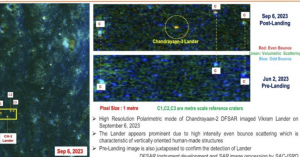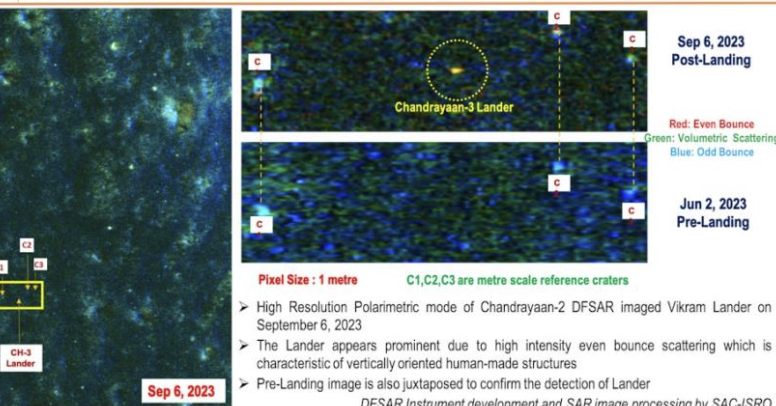NEW DELHI : India made a huge step forward when the Chandrayaan-3 lander module successfully touched down on the moon’s South Pole, becoming the first nation to accomplish the historic achievement and putting an end to the heartbreak of the Chandrayaan-2 crash landing four years earlier. India was the fourth nation to make a successful lunar landing after the United States, China, and Russia. After landing, the Pragyan rover and the Vikram lander each had a specific set of tasks to do on the lunar surface, such as monitoring the relative temperature, listening for activity around it, and looking for the presence of sulphur and other minor elements.: The Chandrayaan-3 lander performed a successful soft landing on the Moon’s South Pole, and the Chandrayaan-2 orbiter, which was already circling the Moon, snapped a photo of it. On September 6, 2023, the Dual-frequency Synthetic Aperture Radar (DFSAR) instrument on board the Chandrayaan-2 Orbiter will observe the Chandrayaan-3 Lander, according to ISRO. An important development was that days before Chandrayaan-3’s soft landing in August, the Chandrayaan-2 orbiter had established a two-way link with the lander module. Additionally, the Chandrayaan-3 landing site was recently seen in a photo taken by the NASA Lunar Reconnaissance Orbiter (LRO) satellite. After a successful soft landing on August 23, the Chandrayaan-3 spacecraft is currently in close proximity to the South Pole of the Moon.The declared goals of Chandrayaan-3, India’s third lunar mission, including a gentle and secure landing, lunar surface wandering, and in-situ scientific investigations. The Pragyan rover and Vikram lander are now in “sleep mode” and are anticipated to awaken on or around September 22, 2023. The most recent update included a 3-dimensional “anaglyph” image of the Chandrayaan-3 Vikram lander taken from the Moon’s south pole by the Indian Space Research agency. Anaglyph is a straightforward method of visualising an object or landscape in three dimensions using stereo or multiple-view photographs.


